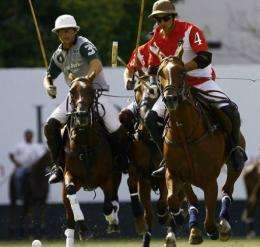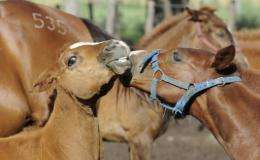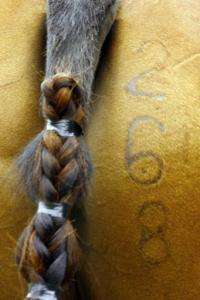Argentine polo players ride their "Polo Argentino" horses during a match in Buenos Aires. A new biotechnology technique has helped boost the number of polo pony breeders in the South American nation from 350 in 2001 to 630 today.
Argentina is vastly expanding its breeding of its world class polo ponies thanks to the use of embryo transfers that help breeders get the most from their top-performing mares and stallions.
The new biotechnology technique has helped increase the number of breeders of polo ponies in the South American nation from 350 in 2001 to 630 today, and has boosted exports of the Polo Argentino horses fourfold between 2006 and 2010, according to the consultancy Unicorn SA.
What is revolutionizing breeding is the use of surrogate mares -- which don't have to be polo ponies.
The technique is relatively simple: the stallion's sperm is used to inseminate the mare. Seven days after the egg is fertilized, the embryo is taken out and transplanted into the uterus of the surrogate mare, which then carries the foal to term.
This allows the top-notch mares, which normally can only give birth to eight foals in a lifetime as the gestation period in horses is 11 months, to produce 30 to 40 babies, or five to 12 annually.
In another benefit, the natural mothers don't have to interrupt their polo activities while the surrogates are carrying their offspring. Pregnant mares can only be safely ridden for the first six months of the pregnancy.
"What the breeders are buying from us is time," said Fernando Riera, owner of the Dona Pilar Centre for Equine Reproduction in Lincoln, some 300 kilometers (200 miles) west of Buenos Aires on the Argentina pampas.
The procedure -- which is also used in the rarified worlds of champion horse-racing and show-jumping -- allows breeders to cross the best pedigrees and boost their chances of obtaining a winner.
The result can look a bit strange.
Young Polo Argentino horses play at a farm in Lincoln, 310km west of Buenos Aires in Argentina.
"See they don't even resemble each other," said Riera, pointing to a chestnut mare in a field nuzzling her black Argentine polo pony.
But he denied this was messing with the natural order of things to create new super horses, saying "we are just helping things along."
At the Argentine Open Polo Championships in Palermo, the biggest event in the sport, "more than half of the horses are from (transplanted) embryos," says Riera, who was trained in the technique in the United States.
He said in some cases, the mares play in the same matches alongside their offspring.
At the La Martona Club de Campo some 50 kilometers (30 miles) from Buenos Aires, Inge Schwenger and her son Helge were on a visit to buy polo ponies for her club near Berlin.
"For a horse of the same quality, we would pay a lot more in Germany," said Helge Schwenger, adding the cost was still lower even if the buyer has to pay to fly a pony back to Europe.
"It's good business for us to have these Argentine polo ponies," said Inge Schwenger, who bought a horse named Primavera (Spring) for $8,000. "People are attracted by the quality of the horses."
The Schwengers considered buying horses from Chile and Uruguay, but said they did not find the same breeding quality as the Argentine ponies.
The braided tail of a Polo Argentino horse is seen before the start of a polo match in Buenos Aires. A new biotechnology process allows top-notch mares, which normally can only give birth to eight foals in a lifetime, to produce 30 to 40 babies, or five to 12 annually.
"They are easier to manage, they have a great character and they are not too nervous. For beginners, there is nothing better," Inge said.
Marcos Heguy, who breeds hundreds horses at a center some 500 kilometers (300 miles) from the capital, said the embryo transfers are a good service for breeders.
"In polo, we have only legs and reins," said Heguy, who comes from a line of breeders of champion horses that sell for up to $100,000.
"With so little, the horse must be able to react very quickly if it is to win."
(c) 2011 AFP





















